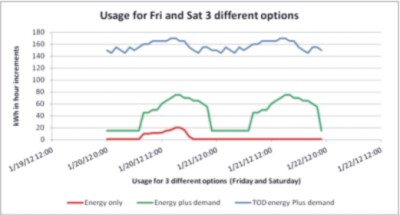
How did I even get on this rate?
In a previous Brief, “Commercial and Industrial Electrical Bills,” an overview of energy and demand charges was provided. Then, the basics of how rates are structured were discussed in “Electrical Rates Demystified“. Now that you have a basic understanding of your energy bills and rates, let’s figure out the details behind your specific rate.
The average facility will fit into one of three basic rate structures (or tariffs): energy only, energy plus demand (charges both kWh and kW), and time-of-day energy plus demand billed (charges on-peak kWh, off-peak kWh and kW).
The tariffs are already set up. Just find the best fit.
For new facilities, utilities gauge the usage of each facility and select one of their existing rates based on the estimated usage. So if it appears a facility will use less than 30,000 kWh per month or less than 100 kW per month, the account will fit into a Small Business tariff with a demand charge. This can be changed either if the customer shows much higher or much lower usage over a few months.
Why facilities have different tariffs?
Let’s take a look at how these tariffs relate to three fictional businesses with different usages as shown in the graph. A large factory that runs 24/7 would be assigned the time-of-day (TOD, otherwise known as time of use for some utilities) energy plus demand rate since most of the operating time is during off-peak hours. Time-of-day rates are usually comparable to their non-TOD counterparts with the main difference being that TOD rates charge a higher demand rate during “on-peak” times of day and a lower demand rate during “off-peak” times of day. The rate may charge for energy the same way. A TOD rate would be ideal if you operated for more hours during the off-peak time period.

For a small shop that is only open 8am-5pm Monday through Friday, TOD is not the best option since the facility operates mostly during the on-peak period. Also, without any large pieces of equipment, the demand for this shop is minimal. For this shop, the energy only rate is the best fit. There is no demand charge on this rate because it is built into the energy charge. Utilities could charge for the demand separately, but for most areas this is not cost-effective. However, with smart-metering (a future topic), demand metering for every customer may be on the way.
For a medium sized business that is open 8am-10pm every day, it may get a little trickier. The demand for this business falls somewhere between that of the shop and the factory, and hours of operation are during both on and off peak time periods. For this it would cost the customer more money to switch to the TOD rate since the majority of the operating time is during on-peak hours, and the non-TOD energy rate is lower.
So what do you do?
Tariffs vary by utility, but most utilities offer optional rates. For example, a customer on an energy only rate may have the option to choose a TOD rate. Or, a customer on a large electric rate may have the option to choose an interruptible rate. These selections can be very beneficial depending on each customer’s situation and some kind of analysis should be performed before making any change in rates. Most utilities will assist with a rate analysis to determine if a different tariff is in the facility’s best interest.




